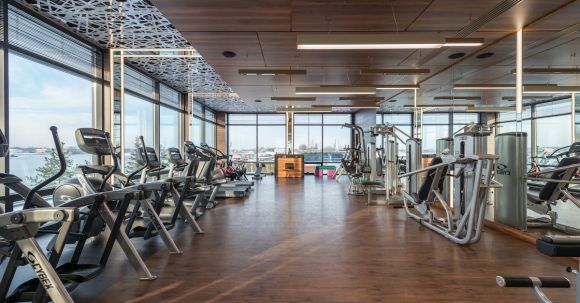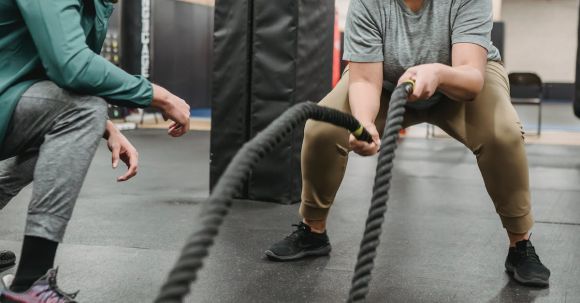Yoga is not just a physical exercise; it is a holistic practice that benefits both the mind and body. One of the major advantages of practicing yoga is the improvement in flexibility and mobility. Yoga flows, a sequence of yoga poses linked together in a continuous movement, are particularly effective in enhancing flexibility and mobility. In this article, we will explore how yoga flows can help you increase your flexibility and mobility, and provide some examples of yoga flows that you can incorporate into your practice.
Blog Posts
Many people believe that building muscle mass requires consuming large amounts of animal protein. However, this is simply not true. As a vegetarian, you can still achieve your muscle-building goals by following a well-balanced and nutrient-rich diet. In this article, we will explore some key strategies to help you build muscle mass as a vegetarian.
1. Prioritize Protein-rich Foods
Protein is crucial for muscle growth and repair, so it is important to include ample amounts of protein in your vegetarian diet. Good sources of vegetarian protein include tofu, tempeh, legumes, lentils, quinoa, Greek yogurt, and eggs. Aim to include protein in each of your meals to ensure a constant supply for muscle synthesis.2. Optimize Amino Acid Intake
While plant-based protein sources are abundant, they may not provide all the essential amino acids in sufficient quantities. To ensure you are getting a complete amino acid profile, consume a variety of protein-rich foods throughout the day. Combinations such as beans and rice, or hummus and whole wheat pita bread, can help you achieve this balance.3. Eat a Variety of Whole Foods
To support muscle growth, it's important to consume a wide range of whole foods. Fruits, vegetables, whole grains, nuts, and seeds are all essential for providing important vitamins, minerals, and antioxidants that aid in muscle recovery and overall health. Aim to include a variety of colorful fruits and vegetables in your diet to obtain a broad spectrum of nutrients.4. Consume Healthy Fats
While protein is often emphasized in muscle-building diets, healthy fats should not be overlooked. Fats play an important role in hormone production, which is crucial for muscle growth and repair. Include plant-based fats such as avocados, nuts, seeds, and olive oil in your diet to support muscle development.5. Time Your Meals Appropriately
To optimize muscle growth, it is important to distribute your protein intake evenly throughout the day. Aim to consume a source of protein every 3-4 hours to provide a constant supply of amino acids to your muscles. This can be achieved by including protein-rich snacks, such as Greek yogurt, cottage cheese, or protein shakes, between your main meals.6. Consider Protein Supplements
If you find it challenging to meet your protein requirements solely through whole foods, protein supplements can be a convenient option. There are many plant-based protein powders available on the market, such as pea, hemp, or brown rice protein, which can be easily added to smoothies or other recipes to boost your protein intake.7. Practice Progressive Overload
Building muscle mass requires progressive overload, which means gradually increasing the intensity of your workouts over time. This can be achieved by increasing the weight, number of repetitions, or sets that you perform. Focus on compound exercises, such as squats, deadlifts, and bench presses, which target multiple muscle groups simultaneously and stimulate muscle growth. In conclusion, building muscle mass as a vegetarian is entirely possible with a well-planned and balanced diet. By prioritizing protein-rich foods, optimizing amino acid intake, consuming a variety of whole foods, and timing your meals appropriately, you can support muscle growth and achieve your fitness goals. Remember to practice progressive overload in your workouts and consider protein supplements if needed. With dedication and consistency, you can build muscle mass and maintain a vegetarian lifestyle.
Strength training, also known as resistance training, involves exercises that use resistance to build muscular strength and endurance. While it is a popular form of exercise for adults, many parents wonder if it is safe for their teenagers to engage in strength training. There are concerns about potential injuries and stunted growth. In this article, we will explore the safety of strength training for teens and provide some guidelines for parents and teenagers.
Understanding the Benefits of Strength Training
Before delving into the safety aspect, it is important to understand the benefits of strength training for teens. Regular strength training can enhance muscular strength and endurance, improve bone density, and help maintain a healthy body weight. It can also have a positive impact on mental health, boosting self-esteem and reducing symptoms of anxiety and depression. Additionally, strength training can improve sports performance and reduce the risk of sports-related injuries.Appropriate Age and Physical Maturity
One of the primary concerns regarding strength training for teens is whether it is appropriate for their age and physical maturity. The American Academy of Pediatrics (AAP) recommends that children and adolescents can safely engage in strength training as long as they are physically mature and have proper supervision. It is generally advised to wait until around the age of 14 or 15 before starting a formal strength training program.Supervision and Proper Technique
Proper supervision is crucial when it comes to strength training for teens. They should be supervised by a qualified trainer or coach who can ensure they are using the correct technique and form. This is important to prevent injuries and maximize the benefits of the exercises. Teenagers should also start with lighter weights and gradually increase the intensity as they progress. It is essential to emphasize the importance of proper warm-up and cool-down routines as well.Avoiding Overtraining and Injuries
Overtraining can be a concern for teenagers who are enthusiastic about strength training. It is important to educate them about the importance of rest and recovery days to allow their muscles to repair and grow. Pushing too hard without adequate rest can lead to overuse injuries and hinder progress. It is also important to encourage them to listen to their bodies and not push through pain or discomfort.Addressing the Concerns about Stunted Growth
One common myth about strength training for teens is that it can stunt their growth. However, research has shown that when performed with proper technique and under appropriate supervision, strength training does not have any negative impact on growth plates or overall height. In fact, it can actually promote healthy bone development and increase bone density, which is especially important during adolescence.Conclusion: The Importance of Safety and Proper Guidance
In conclusion, strength training can be safe and beneficial for teenagers when done with proper guidance and supervision. It is important for parents to support their teens' interest in strength training and ensure they have access to qualified trainers or coaches. By following proper techniques, gradually increasing intensity, and allowing for adequate rest and recovery, teens can safely enjoy the many benefits of strength training. It is important to remember that every teenager is different, so it is always a good idea to consult with a healthcare professional before starting any new exercise program.
In today's fast-paced world, finding time to hit the gym can be a challenge. But thanks to technology, we now have the option to train like a pro from the comfort of our own homes. Fit On's Online Personal Training is revolutionizing the way we stay fit, offering personalized workout plans and expert guidance right at our fingertips. Let's delve into the world of online personal training and discover how it can help us achieve our fitness goals.
Customized Workout Plans for Every Goal
One of the key advantages of Fit On's Online Personal Training is the ability to receive customized workout plans tailored to your specific goals. Whether you want to lose weight, build muscle, or improve overall fitness, Fit On has got you covered. By providing information about your current fitness level, preferences, and goals, Fit On's team of expert trainers will create a personalized plan that maximizes your results. No more wasting time on generic workouts that may not align with your objectives - with Fit On, every exercise counts.Flexible Training Schedule
Gone are the days of rigid gym schedules. With Fit On's Online Personal Training, you have the freedom to train whenever and wherever you want. Whether you're an early riser or a night owl, you can fit in your workout routine at a time that suits you best. The flexibility of online training allows you to seamlessly integrate exercise into your daily routine, making it easier to stay consistent and achieve long-term results.Expert Guidance from Certified Trainers
One of the biggest concerns when it comes to online training is the lack of personal guidance. However, Fit On ensures that you receive expert support every step of the way. Their team of certified trainers is readily available to answer any questions, provide feedback on your progress, and offer guidance on proper form and technique. With Fit On's Online Personal Training, you never have to worry about navigating your fitness journey alone.Variety of Workouts to Keep You Motivated
Boredom can be a major obstacle when it comes to sticking to a workout routine. Fit On understands this and offers a wide variety of workout options to keep you motivated and engaged. From strength training and cardio workouts to yoga and Pilates, there is something for everyone. The platform also regularly updates its library, ensuring that you always have fresh and exciting workouts to choose from. Say goodbye to monotonous exercise routines and hello to a world of variety with Fit On's Online Personal Training.Affordable and Convenient
One of the greatest advantages of Fit On's Online Personal Training is its affordability. Traditional personal training sessions can be costly, making it difficult for many people to access professional guidance. Fit On offers an affordable alternative that brings the expertise of certified trainers to your fingertips without breaking the bank. Additionally, the convenience of online training eliminates the need for commuting to the gym, saving you time and money in the long run.Train Like a Pro with Fit On's Online Personal Training
In conclusion, Fit On's Online Personal Training provides a convenient and effective way to train like a pro. With customized workout plans, flexible training schedules, expert guidance, a variety of workouts, and affordability, Fit On has everything you need to achieve your fitness goals. Say goodbye to excuses and hello to a healthier, fitter you with Fit On's Online Personal Training. Start your journey today and experience the transformative power of virtual personal training.
Cholesterol is a fatty substance that is found in the blood. While the body needs cholesterol to build healthy cells, having high levels of cholesterol can increase the risk of heart disease. Regular exercise, particularly cardiovascular exercises, can play a significant role in reducing cholesterol levels and promoting heart health. In this article, we will explore some effective cardiovascular exercises that can help lower cholesterol levels.
Running
Running is a popular and effective cardiovascular exercise that can help reduce cholesterol levels. It is a high-impact activity that engages multiple muscle groups and increases heart rate. Running not only burns calories but also helps boost the production of high-density lipoprotein (HDL) cholesterol, which is known as the "good" cholesterol. Regular running can increase HDL cholesterol levels and decrease low-density lipoprotein (LDL) cholesterol levels, thereby reducing the risk of heart disease.
Cycling
Cycling is a low-impact cardiovascular exercise that can be easily incorporated into daily routines. Whether it's a leisurely bike ride or a vigorous cycling session, this activity helps improve cardiovascular health and lowers cholesterol levels. Cycling primarily targets the leg muscles, but it also engages the core and upper body muscles. Regular cycling can help increase HDL cholesterol levels and decrease LDL cholesterol levels, leading to better heart health.Swimming
Swimming is a full-body workout that is gentle on the joints, making it an ideal cardiovascular exercise for people of all fitness levels. It works all major muscle groups and provides a great cardiovascular workout. Swimming not only burns calories but also increases lung capacity and strengthens the heart. Regular swimming can help raise HDL cholesterol levels and lower LDL cholesterol levels, thereby reducing the risk of heart disease.High-Intensity Interval Training (HIIT)
High-Intensity Interval Training (HIIT) is a form of cardiovascular exercise that alternates between short bursts of intense exercise and brief recovery periods. This type of workout is highly effective in burning calories and improving cardiovascular fitness. HIIT exercises can include activities such as sprinting, jumping jacks, and burpees. Studies have shown that HIIT can significantly reduce total cholesterol and LDL cholesterol levels, making it an excellent choice for those looking to lower their cholesterol levels.Aerobic Dance
Aerobic dance classes, such as Zumba or aerobics, combine dance movements with cardiovascular exercises. These classes are not only fun and engaging but also effective in burning calories and improving heart health. Aerobic dance helps increase heart rate, strengthen muscles, and improve coordination. Regular participation in aerobic dance classes can lead to increased HDL cholesterol levels and decreased LDL cholesterol levels. Incorporating cardiovascular exercises into your routine can help lower cholesterol levels and improve heart health. Remember to start gradually and consult with a healthcare professional before beginning any new exercise program, especially if you have existing health conditions. Aim for at least 150 minutes of moderate-intensity aerobic exercise or 75 minutes of vigorous-intensity aerobic exercise per week, and spread the sessions throughout the week for maximum benefits. By making cardiovascular exercises a regular part of your routine, you can take control of your cholesterol levels and promote a healthy heart. So lace up your running shoes, hop on your bike, or dive into the pool, and start reaping the benefits of these cholesterol-reducing exercises today. Your heart will thank you!
In today's competitive sports world, athletes are constantly seeking ways to gain an edge over their opponents. One way to do this is through sports-specific training. By tailoring their workouts to the specific demands of their sport, athletes can improve their performance and reach new levels of success. In this article, we will explore the benefits of sports-specific training and provide tips on how to incorporate it into your own routine.
Understanding Sports-specific Training
Sports-specific training involves designing a training program that focuses on the skills, movements, and physical attributes required for a particular sport. This type of training goes beyond the general fitness activities that athletes typically engage in, such as running or weightlifting. Instead, it hones in on the specific movements and muscle groups used in the athlete's sport of choice.The Benefits of Sports-specific Training
1. Improved Performance: By targeting the specific skills and movements used in a sport, athletes can enhance their performance in those areas. For example, a basketball player may focus on agility drills and shooting exercises to improve their speed and accuracy on the court. By training in a sport-specific manner, athletes can refine their skills and become more proficient in their chosen sport. 2. Injury Prevention: Sports-specific training can also help reduce the risk of injury. By strengthening the muscles used in a particular sport and improving flexibility and mobility, athletes can better withstand the physical demands of their sport. For instance, a soccer player may engage in exercises that strengthen the muscles around the knee to prevent common soccer-related injuries, such as ACL tears. 3. Mental Preparation: Sports-specific training not only benefits athletes physically but also mentally. By mimicking the movements and intensity of their sport during training, athletes can better prepare themselves for the mental challenges they may face during competition. This type of training helps athletes develop focus, concentration, and mental resilience, which are crucial for success in any sport.Incorporating Sports-specific Training into Your Routine
1. Identify the Key Skills: The first step in sports-specific training is to identify the key skills required for your sport. Take some time to analyze the movements, muscle groups, and physical attributes that are essential for success in your chosen sport. This will help you tailor your training program accordingly. 2. Design a Training Program: Once you have identified the key skills, design a training program that targets those areas. Incorporate exercises and drills that mimic the movements used in your sport. For example, a tennis player may include agility ladder drills and medicine ball exercises to improve their footwork and power. 3. Seek Professional Guidance: If you're unsure about how to design a sports-specific training program, seek the guidance of a sports performance coach or a certified trainer. They can help you create a program that is tailored to your specific needs and goals. 4. Monitor Progress: As with any training program, it's important to monitor your progress and make adjustments as needed. Keep track of your performance and assess whether your training program is helping you reach your goals. If necessary, make changes to your program to ensure that you continue to challenge yourself and progress.Elevate Your Game with Sports-specific Training
In conclusion, sports-specific training is a valuable tool for athletes looking to elevate their performance. By targeting the specific skills, movements, and physical attributes required for their sport, athletes can improve their performance, prevent injuries, and enhance their mental preparation. By incorporating sports-specific training into your routine and seeking professional guidance when needed, you can take your game to the next level and achieve greater success in your chosen sport.
In our fast-paced world, finding inner peace can often feel like an elusive goal. The demands of work, family, and everyday life can leave us feeling overwhelmed and disconnected from ourselves. However, there is a powerful tool that can help us find balance and tranquility amidst the chaos: mindfulness. If you're looking to cultivate a sense of inner peace and well-being, then the Fit on Mindfulness Challenge is the perfect opportunity for you.
What is mindfulness?
Mindfulness is the practice of bringing one's attention to the present moment, without judgment. It involves paying attention to our thoughts, feelings, and bodily sensations, as well as the world around us. By cultivating mindfulness, we can develop a greater awareness of ourselves and our surroundings, which can lead to a deeper sense of inner peace.Why join the Fit on Mindfulness Challenge?
The Fit on Mindfulness Challenge is a 30-day program designed to help you incorporate mindfulness into your daily life. By participating in this challenge, you will have the opportunity to learn a variety of mindfulness techniques and practices that can help you find calmness and balance in your day-to-day activities.Benefits of mindfulness
1. Stress reduction: Mindfulness has been shown to reduce stress levels by helping us become more aware of our stress triggers and learning how to respond to them in a calm and focused manner. 2. Improved focus and concentration: Regular mindfulness practice can enhance our ability to concentrate, making us more productive and efficient in our work and personal lives. 3. Enhanced emotional well-being: Mindfulness can help us become more in tune with our emotions, allowing us to better regulate them and experience greater overall happiness and contentment. 4. Better physical health: Mindfulness has been linked to a variety of physical health benefits, including reduced blood pressure, improved sleep quality, and enhanced immune function.How to participate in the Fit on Mindfulness Challenge
1. Sign up: Visit the Fit on Mindfulness website and sign up for the challenge. You will receive a daily email with instructions and resources to guide you through each day's practice. 2. Set aside time: Dedicate a specific time each day to engage in mindfulness practice. This could be in the morning before starting your day, during your lunch break, or in the evening before bed. 3. Start with guided meditations: Begin your mindfulness journey with guided meditations, which can help you focus your attention and cultivate a sense of calm. There are many apps and online resources available that offer guided meditations for free. 4. Incorporate mindfulness into daily activities: As you progress in the challenge, start incorporating mindfulness into your daily activities, such as eating, walking, or even doing household chores. Pay attention to the sensations, smells, and sounds around you, allowing yourself to fully experience each moment. 5. Join a community: Connect with other participants in the Fit on Mindfulness Challenge through online forums or social media groups. Sharing your experiences and insights with others can enhance your mindfulness practice and provide a sense of support and accountability.Conclusion: Embrace the Fit on Mindfulness Challenge
If you're ready to embark on a journey towards inner peace and well-being, then the Fit on Mindfulness Challenge is an excellent opportunity to do so. By dedicating just a few minutes each day to mindfulness practice, you can experience profound shifts in your mental, emotional, and physical well-being. So, join the challenge and discover the transformative power of mindfulness in your life.
Eating out can be a challenge when you're trying to maintain a healthy lifestyle. With so many tempting options and hidden calories, it's easy to derail your diet goals. However, with a little planning and smart choices, you can still enjoy dining out without sacrificing your health.
1. Research the Menu
Before heading to a restaurant, take a few minutes to look up their menu online. This will give you a chance to review the options and identify healthier choices. Look for dishes that are grilled, baked, or steamed instead of fried. Also, pay attention to portion sizes and opt for smaller portions or share a meal with a friend if necessary.2. Watch Out for Hidden Calories
When dining out, it's important to be mindful of hidden calories. Many dishes may appear healthy but are loaded with added sugars, unhealthy fats, and excessive sodium. Avoid dishes that are heavily sauced or creamy, as these tend to be higher in calories. Instead, opt for meals that are prepared with fresh ingredients and simple seasonings.3. Control Your Portions
Portion sizes at restaurants are often much larger than what you would typically eat at home. To avoid overeating, consider sharing a meal with a friend or ask for a takeout container when your food arrives and pack up half of your meal to enjoy later. Another option is to order an appetizer or a small plate as your main course, as these are usually more reasonably sized.4. Choose Healthier Cooking Methods
When it comes to cooking methods, some are healthier than others. Opt for dishes that are grilled, baked, or steamed instead of fried. These cooking methods reduce the amount of added fats and calories, making your meal healthier overall. If you're unsure about how a dish is prepared, don't hesitate to ask your server.5. Be Mindful of Beverages
Beverages can be a hidden source of calories and sugar. Avoid sugary drinks such as soda, sweetened iced tea, and fruit juices. Instead, opt for water, unsweetened tea, or sparkling water with a splash of citrus for flavor. If you prefer alcoholic beverages, choose light options like a glass of wine or a low-calorie beer.6. Load Up on Vegetables
Most restaurants offer a variety of vegetables as sides or in salads. Take advantage of these options and load up on vegetables to increase your nutrient intake. Choose steamed or roasted vegetables instead of those cooked in butter or oil. Also, ask for dressings and sauces on the side, so you have control over how much you use.7. Practice Mindful Eating
Eating out often involves socializing and distractions, which can lead to mindless eating. Practice mindful eating by paying attention to your hunger and fullness cues. Take your time to savor each bite and chew slowly. Put your fork down between bites and engage in conversation to slow down your eating pace. Conclusion: Eating out doesn't have to mean abandoning your healthy eating habits. By doing a little research, making smart choices, and practicing mindful eating, you can enjoy dining out while still staying on track with your health goals. Remember, moderation is key, and it's okay to indulge occasionally. With these tips in mind, you can navigate restaurant menus with confidence and make choices that align with your healthy lifestyle.
In today's fast-paced world, finding ways to relax and reduce stress is more important than ever. One popular method that has gained traction in recent years is the practice of yoga and meditation. Not only does it help to calm the mind and improve focus, but it also provides numerous physical benefits such as increased flexibility and strength. If you're interested in starting a yoga and meditation routine but don't know where to begin, this article will guide you through the process.
Understanding the Basics
Before diving into the world of yoga and meditation, it's essential to understand the basics. Yoga is an ancient practice that combines physical postures, breathing techniques, and meditation to promote overall well-being. Meditation, on the other hand, is a practice that involves focusing the mind and achieving a state of deep relaxation and mental clarity. Both practices go hand in hand and complement each other perfectly.Setting Your Goals
The first step in starting a yoga and meditation routine is to set your goals. What do you hope to achieve through this practice? Are you looking to reduce stress, increase flexibility, or improve your overall well-being? By identifying your goals, you can tailor your routine to meet your specific needs. Remember, everyone's journey is unique, so it's important to focus on what you want to achieve rather than comparing yourself to others.Finding a Suitable Space
Creating a peaceful and dedicated space for your yoga and meditation practice is crucial. Look for a quiet area in your home where you can set up a yoga mat or meditation cushion. It should be free from distractions and have enough room for you to move comfortably. Consider adding elements that promote relaxation, such as candles, incense, or calming music. This designated space will help you establish a routine and make it easier to disconnect from the outside world.Starting with Simple Poses and Techniques
As a beginner, it's essential to start with simple yoga poses and meditation techniques. Trying to tackle advanced postures and deep meditation right from the start can be overwhelming and discouraging. Begin by practicing basic poses such as child's pose, downward dog, and mountain pose. These poses will help you build strength, flexibility, and body awareness. When it comes to meditation, start with short sessions of five to ten minutes and gradually increase the duration as you become more comfortable.Creating a Routine
Consistency is key when it comes to establishing a yoga and meditation routine. Set aside a specific time each day for your practice, whether it's in the morning, during lunch breaks, or in the evening. Having a regular schedule will make it easier to develop a habit and ensure that you prioritize your practice. Remember, even a few minutes of yoga and meditation each day can make a significant difference in your overall well-being.Seeking Guidance
If you're new to yoga and meditation, seeking guidance from an experienced instructor can be incredibly beneficial. Consider taking a beginner's yoga class or joining a meditation group in your area. These resources will provide you with proper guidance and help you avoid common mistakes. Additionally, learning from others can inspire and motivate you to continue your practice.Conclusion: Embracing a New Lifestyle
Starting a yoga and meditation routine is a journey of self-discovery and personal growth. By understanding the basics, setting goals, creating a suitable space, starting with simple poses and techniques, establishing a routine, and seeking guidance, you can embark on this transformative path. Remember to be patient with yourself, listen to your body, and enjoy the process. Embrace this new lifestyle and watch as it positively impacts your physical, mental, and emotional well-being.
Are you looking to take your athletic performance to the next level? If so, incorporating sports-specific exercises into your training routine can be a game-changer. These exercises are designed to target the specific movements, muscles, and skills required for your chosen sport, helping you become stronger, faster, and more efficient on the field or court. Whether you're a basketball player, a soccer enthusiast, or a tennis pro, here are some sports-specific exercises to help you develop your skills and reach your full potential.









